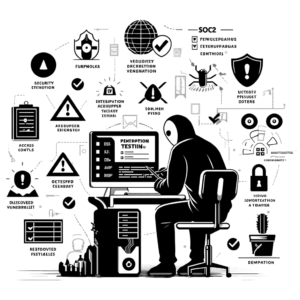Understanding Penetration Testing SOC 2 Certification
What is Penetration Testing?
In the world of online security, penetration testing is an important tool to keep systems and networks safe. Penetration testing, also called pen testing, is like a pretend cyberattack on a computer system to find any weak spots that bad hackers might try to take advantage of. For businesses looking to get SOC 2 certification, penetration testing is a key way to make sure their security measures are working well and to find any areas that might need improvement in their systems.
Pentesting is a way to see how secure a company’s computer systems are by intentionally trying to break into them. This helps find any weaknesses so companies can fix them before real cybercriminals can take advantage of them.
When getting ready for SOC 2 certification, companies should know that it’s crucial to regularly test their systems’ security through penetration testing. By working with cybersecurity experts, businesses can make sure that their systems are thoroughly tested and secure. This will help improve overall security and meet the requirements of SOC 2 standards.
What is SOC 2 Certification?
Having a SOC 2 certification is important for organizations that store sensitive customer information in the cloud. It shows that a company is serious about keeping data secure and private. This certification is based on a set of guidelines created by a group of accountants and looks at how well a company protects customer data, makes sure it’s available when needed, and keeps it confidential.
Regularly testing for vulnerabilities is important for organizations to achieve and maintain their SOC 2 certification. By conducting penetration tests, companies can find weaknesses in their systems and applications that could be used by hackers. This helps companies improve their security measures, reduce risks, and protect sensitive data.
Understanding the significance of SOC 2 compliance and the role of pentesting is vital for organizations striving to safeguard their data and maintain regulatory compliance in today’s increasingly complex cyber threat landscape.
The Roles of Pentesting in Achieving SOC 2 Compliance
Uncovering Security Vulnerabilities
Conducting penetration testing is very important in meeting SOC 2 compliance requirements. It helps your organization find and fix security weaknesses in systems and processes, making it harder for cybercriminals to steal important information. During a penetration test, experts pretend to be hackers and try to break into your systems. This test checks how well your security measures work and shows where improvements are needed.
It’s important for companies to do pentest if they want to get SOC 2 certification, which shows they have strong security measures in place. Penetration tests help businesses see if they have any weaknesses in their security and find ways to make their defenses stronger. It also shows customers that they take protecting data seriously. Testing can help organizations improve their security and be better prepared for cyber attacks.
Penetration Testing and Trust Service Criteria
Penetration testing is an important process for companies looking to achieve SOC 2 certification. It involves testing systems and applications for weaknesses to ensure they are secure. This helps companies understand how effective their security measures are and whether they meet the criteria set forth in the SOC 2 framework. The criteria include security, availability, processing integrity, confidentiality, and privacy, which are essential for obtaining certification. Pentesting helps companies show that they are compliant with these criteria by simulating cyber attacks and finding any vulnerabilities that could be exploited by hackers.
For companies looking to achieve SOC 2 certification, it’s crucial to understand the significance of security testing in meeting the Trust Service Criteria. Pentesting helps firms identify and address security vulnerabilities before they are exploited by hackers. This not only enhances overall security but also lowers the risk of data breaches and cyber attacks. Given the ever-evolving nature of cyber threats, it is an essential measure for companies to safeguard their sensitive data and demonstrate their commitment to meeting SOC 2 standards.
Types of Penetration Tests to Consider for SOC 2
External Penetration Testing
External pentest is an important part of getting SOC 2 Certification. It means simulating cyber attacks on a company’s outside systems to find weaknesses that hackers could use. This helps the company know how safe their data is and prevents unauthorized access. Doing regular external penetration testing can find and fix security issues before hackers can use them.
During security testing, ethical hackers use different tools and methods to find out weaknesses in network setups, websites, and computer servers. They try to take advantage of weaknesses like settings that are done wrong, outdated software, and easy-to-guess passwords to get into an organization’s systems without permission. When these weaknesses are found, organizations can fix them to improve their security.
Pentesting from outside sources is very important for obtaining SOC 2 Certification. It shows that an organization is serious about keeping their data safe and following the rules set by the industry. By doing this kind of testing on a regular basis, companies can make sure they are prepared for new cyber threats and keep their confidential information secure.
Internal Penetration Testing

Internal pentest is an important step in getting SOC 2 certification. It involves testing your organization’s network to see if it could be vulnerable to cyber attacks from within. This testing helps find any weaknesses that hackers could use to break into your systems. By doing this type of testing, you can learn how secure your systems and networks are and fix any problems before they become serious issues.
In internal pentest, cybersecurity experts use different methods to check for weaknesses in your internal network. They may find and take advantage of things like incorrect settings, easy-to-guess passwords, outdated software, or other gaps in security to get into important data or systems without permission. By finding and fixing these problems, companies can make their security stronger and prevent possible cyberattacks.
Furthermore, internal penetration testing is a requirement for SOC 2 compliance, as it demonstrates your commitment to safeguarding sensitive information and maintaining a secure environment for your clients’ data. By conducting regular internal penetration tests, you can proactively identify and address security weaknesses, ultimately strengthening your cybersecurity defenses.
The Process of Conducting Penetration Testing for SOC 2
Planning and Reconnaissance
When preparing for a pentest as part of the SOC 2 certification process, thorough planning and reconnaissance are essential steps to ensure a successful assessment of your security controls. Planning involves defining the scope of the test, setting clear objectives, and identifying the potential risks and vulnerabilities that need to be assessed. This phase is crucial for determining the target systems and applications to be tested, as well as understanding the specific compliance requirements of SOC 2.
Reconnaissance is all about gathering information on a target organization’s infrastructure, systems, and applications. The goal is to find any weak spots or vulnerabilities that could potentially be used by a hacker to break in. By doing a thorough reconnaissance, penetration testers can recreate real-world attacks and pinpoint any security holes that need to be fixed in order to comply with SOC 2 standards.
Overall, effective planning and reconnaissance are critical components of a successful penetration testing process for SOC 2 certification, helping organizations proactively identify and mitigate security risks to protect their sensitive data and maintain compliance with industry standards.
Testing and Reporting
When getting SOC 2 certification, one important step is a penetration test. This means checking an organization’s systems and networks to find any weaknesses that could be used by hackers. Penetration testing helps see how well an organization’s security measures work and make sure they meet the strict requirements of SOC 2 compliance.
As part of penetration testing SOC 2 certification, thorough testing and reporting are essential steps in the process. Testing involves simulating real-world cyberattacks to evaluate the security posture of the organization comprehensively. Skilled cybersecurity professionals utilize a variety of tools and techniques to uncover weaknesses and potential entry points that could compromise sensitive data.
Once the testing phase is complete, detailed reporting is critical for documenting findings, outlining remediation steps, and demonstrating compliance with SOC 2 requirements. The report provides valuable insights into the security gaps identified during testing, allowing the organization to prioritize and address vulnerabilities effectively.
In summary, testing and reporting are fundamental aspects of penetration testing SOC 2 certification, ensuring that organizations have a robust security framework in place to protect their data and meet industry compliance standards.
The Significance of Penetration Testing for SOC 2 Certification
In summary, pentesting is really important for organizations that deal with sensitive information and want to get SOC 2 certification. By carefully testing and analyzing systems and networks, penetration testing helps find any weaknesses that hackers could potentially take advantage of. With this information, organizations can quickly fix any vulnerabilities before they become a problem. SOC 2 certification shows that a company is dedicated to keeping data secure and private, and penetration testing is a key part of that dedication.
Regular penetration testing helps organizations assess their security, find weak points that hackers could exploit, and improve overall defense. This proactive approach helps meet security standards and better respond to cyber threats.
Furthermore, it provides valuable insights into the effectiveness of an organization’s security controls and incident response procedures. By simulating real-world cyber attacks, it helps organizations evaluate their readiness to defend against and mitigate security breaches, ultimately leading to a more robust security infrastructure.
It is important for organizations seeking SOC 2 certification to recognize the continuous nature of cybersecurity threats and the evolving tactics employed by malicious actors. Regular testing, complemented by comprehensive security assessments, is essential in maintaining a proactive cybersecurity posture and ensuring ongoing compliance with SOC 2 requirements.
Pentesting is more than just a checklist requirement for SOC 2 certification. It’s an important investment in making sure our cybersecurity defenses are strong, protecting our sensitive information, and building trust with our customers. Companies that prioritize penetration testing are better prepared to handle cyber threats and show that they take data security and privacy seriously.
